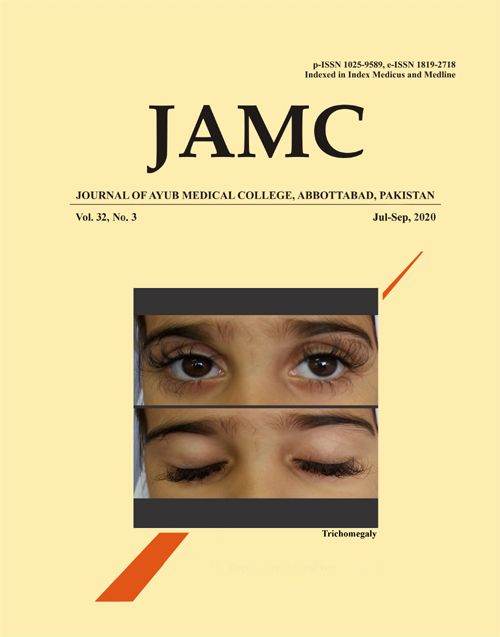LABORATORY BLOOD TESTING IN PAEDIATRIC INTENSIVE CARE UNIT OF A UNIVERSITY HOSPITAL: ARE WE DOING IT APPROPRIATELY?
Abstract
Retrospective chart review of all children (aged-one month to 16yr) admitted in our paediatric intensive care from June to November 2016 was done to determine the indication of different laboratory tests. LBT indications were defined into: diagnostic/case findings/screening tests to make a diagnosis; haemostatic tests (to monitor function or identify before clinical signs and symptoms) and therapeutic /monitoring tests to get the level of drug directly or getting level of marker as a guide to therapy. Laboratory tests reports which were within normal range more than once were labelled as in-appropriate tests. In total 274 patients, Haemostatic tests were performed for mean of 35.18±56.72 times (range of 0-429), monitoring for mean of 9.38±20 times (range 0-165), and therapeutic tests (3.26±11.25). Most common tests included serum Sodium levels (7.83±12.73), Serum Potassium (8.19±12.80), bicarbonate (7.75±11.9). 13.40±9.11 tests were done on first day and 13.0±8.49/day tests were performed afterwards. Cumulatively 54.31±74.21 tests were performed/ patients out of which 18.5±37.82 were inappropriate.
Keywords: Laboratory testing; PICU; Indications
References
Ezzie ME, Aberegg SK, O'Brien Jr JM. Laboratory testing in the intensive care unit. Crit Care Clin 2007;23(3):435-65.
Frassica JJ. Frequency of laboratory test utilization in the intensive care unit and its implications for large-scale data collection efforts. J Am Med Inform Assoc 2005;12(2):229-33.
Lin JC, Strauss RG, Kulhavy JC, Johnson KJ, Zimmerman MB, Cress GA, et al. Phlebotomy overdraw in the neonatal intensive care nursery. Pediatrics 2000;106(2):E19.
Haque A, Siddiqui NU, Kumar R, Hoda M, Lakahni G, Hooda K. Cost of care in a paediatric intensive care unit of a tertiary-care university hospital of Pakistan. J Pak Med Assoc 2015;65(6):651-4.
Wang TJ, Mort EA, Nordberg P, Chang Y, Cadigan ME, Mylott L, et al. A utilization management intervention to reduce unnecessary testing in the coronary care unit. Arch Intern Med 2002;162(16):1885-90.
Dewan M, Galvez J, Polsky T, Kreher G, Kraus B, Ahumada L, et al. Reducing Unnecessary Postoperative Complete Blood Count Testing in the Pediatric Intensive Care Unit. Perm J 2017;21:16-51.
Calderon-Margalit R, Mor-Yosef S, Mayer M, Adler B, Shapira SC. An administrative intervention to improve the utilization of laboratory tests within a university hospital. Int J Qual Health Care 2005;17(3):243-8.
Kumwilaisak K, Noto A, Schmidt UH, Beck CI, Crimi C, Lewandrowski K, et al. Effect of laboratory testing guidelines on the utilization of tests and order entries in a surgical intensive care unit. Crit Care Med 2008;36(11):2993-9.
Downloads
Published
How to Cite
Issue
Section
License
Journal of Ayub Medical College, Abbottabad is an OPEN ACCESS JOURNAL which means that all content is FREELY available without charge to all users whether registered with the journal or not. The work published by J Ayub Med Coll Abbottabad is licensed and distributed under the creative commons License CC BY ND Attribution-NoDerivs. Material printed in this journal is OPEN to access, and are FREE for use in academic and research work with proper citation. J Ayub Med Coll Abbottabad accepts only original material for publication with the understanding that except for abstracts, no part of the data has been published or will be submitted for publication elsewhere before appearing in J Ayub Med Coll Abbottabad. The Editorial Board of J Ayub Med Coll Abbottabad makes every effort to ensure the accuracy and authenticity of material printed in J Ayub Med Coll Abbottabad. However, conclusions and statements expressed are views of the authors and do not reflect the opinion/policy of J Ayub Med Coll Abbottabad or the Editorial Board.
USERS are allowed to read, download, copy, distribute, print, search, or link to the full texts of the articles, or use them for any other lawful purpose, without asking prior permission from the publisher or the author. This is in accordance with the BOAI definition of open access.
AUTHORS retain the rights of free downloading/unlimited e-print of full text and sharing/disseminating the article without any restriction, by any means including twitter, scholarly collaboration networks such as ResearchGate, Academia.eu, and social media sites such as Twitter, LinkedIn, Google Scholar and any other professional or academic networking site.










